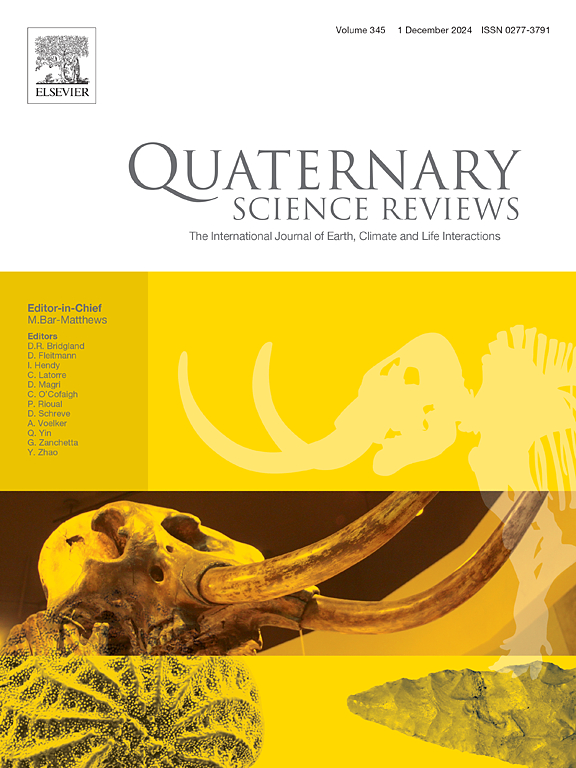Large-scale vegetation shifts during substantial warming — Proxy-based biome reconstructions of MIS 6 and MIS 5e in Europe
IF 3.2
1区 地球科学
Q1 GEOGRAPHY, PHYSICAL
引用次数: 0
Abstract
The climatic changes from the penultimate glacial (MIS 6) to the last interglacial (MIS 5e) and their impact on regional vegetation and the environment inhabited by Neanderthals were profound. While terrestrial pollen data and vegetation reconstructions for MIS 5e are plenty, only few records are available for MIS 6 with no biome reconstruction published so far. Thus, 112 plant fossil sites from Europe and the Near East were compiled in this study, and qualitative and quantitative biome reconstructions were performed for MIS 6 and MIS 5e. This led to the first pollen based spatial reconstruction of vegetation cover for the penultimate glacial. As expected, vegetation patterns change severely and vegetation density increased with the substantial warming from MIS 6 to MIS 5e. Generally, in MIS 6 central and northern Europe was mainly covered by tundra/mammoth steppe, while temperate grassland, open woodland and shrubland dominated southern Europe. During MIS 5e, Europe was largely forested, with temperate forest in the north and warm forests and shrubland in the south. Still, climatic changes from the penultimate glacial to the last interglacial had regionally different effects on vegetation especially regarding the pace and severity of vegetation overturn. Comparison with published model outputs enables a sound spatial representation of large-scale vegetation patterns on megabiome level. Reducing the granularity of the data of both model and proxy-based biome reconstructions to megabiome level leads to a high level of agreement. Still, some discrepancies remain especially in the northern and easternmost parts of Europe, which could be due to dating issues. However, an underestimation of high latitude warming by the underlying climate models may also contribute to discrepancies in vegetation models compared to proxy data. Overall, the results reveal insights into the regional and local vegetation structure and may serve as an informed basis for spatial analyses of the environmental preferences of Neanderthals.
气候变暖期间大尺度植被变化——基于代用因子的欧洲MIS 6和MIS 5e生物群系重建
从第二次冰期(MIS 6)到最后一次间冰期(MIS 5e)的气候变化及其对区域植被和尼安德特人居住环境的影响是深远的。虽然MIS 5e的陆生花粉数据和植被重建非常丰富,但MIS 6的记录很少,迄今为止还没有发表过生物群系重建。因此,本研究收集了欧洲和近东地区的112个植物化石遗址,对MIS 6和MIS 5e进行了定性和定量的生物群系重建。这导致了第一次基于花粉的植被覆盖空间重建。从MIS 6到MIS 5e,植被格局变化剧烈,植被密度增加。总体而言,在MIS 6中,中欧和北欧主要被冻土带/猛犸象草原覆盖,而南欧则以温带草原、开阔林地和灌丛为主。在MIS 5e期间,欧洲大部分是森林,北部是温带森林,南部是温暖的森林和灌木。然而,从第二次冰期到最后一次间冰期的气候变化对植被的影响存在区域差异,特别是在植被翻覆的速度和严重程度方面。与已发表的模型输出进行比较,可以在兆群落水平上对大尺度植被格局进行良好的空间表征。将基于模型和基于代理的生物群落重建的数据粒度降低到兆组级,可以获得高度的一致性。尽管如此,一些差异仍然存在,特别是在欧洲北部和最东部地区,这可能是由于年代问题。然而,潜在气候模式对高纬度变暖的低估也可能导致植被模式与替代数据的差异。总的来说,这些结果揭示了区域和当地植被结构的见解,并可能作为尼安德特人环境偏好的空间分析的知情基础。
本文章由计算机程序翻译,如有差异,请以英文原文为准。
求助全文
约1分钟内获得全文
求助全文
来源期刊

Quaternary Science Reviews
地学-地球科学综合
CiteScore
7.50
自引率
15.00%
发文量
388
审稿时长
3 months
期刊介绍:
Quaternary Science Reviews caters for all aspects of Quaternary science, and includes, for example, geology, geomorphology, geography, archaeology, soil science, palaeobotany, palaeontology, palaeoclimatology and the full range of applicable dating methods. The dividing line between what constitutes the review paper and one which contains new original data is not easy to establish, so QSR also publishes papers with new data especially if these perform a review function. All the Quaternary sciences are changing rapidly and subject to re-evaluation as the pace of discovery quickens; thus the diverse but comprehensive role of Quaternary Science Reviews keeps readers abreast of the wider issues relating to new developments in the field.
 求助内容:
求助内容: 应助结果提醒方式:
应助结果提醒方式:


